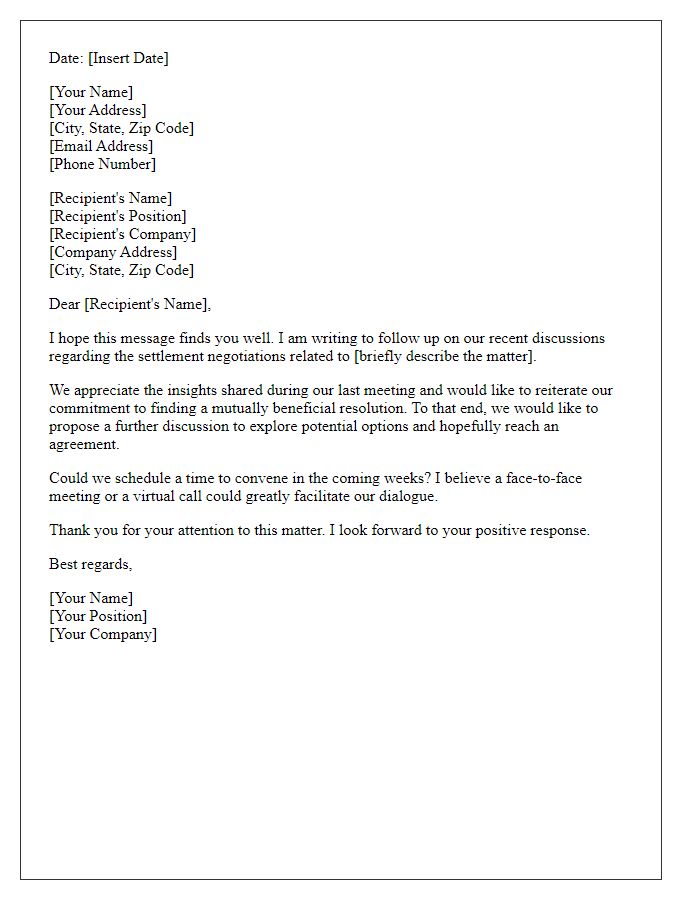When embarking on a settlement negotiation, it's crucial to have a well-crafted letter that clearly outlines your intentions and expectations. This letter serves not only as a formal document but also as a bridge to foster open communication between all parties involved. By ensuring that your thoughts are articulated in a respectful and coherent manner, you lay the groundwork for a more amicable resolution. If you want to explore further on how to create an effective settlement negotiation agreement letter, read on for some helpful tips!

Clear identification of parties involved
The settlement negotiation agreement clearly identifies the parties involved, including individuals and entities. For instance, in a legal context, it may include "Plaintiff John Smith, residing at 123 Elm Street, Springfield, Illinois, ZIP code 62701," and "Defendant Acme Corporation, with a registered office at 456 Oak Avenue, Springfield, Illinois, ZIP code 62702." This identification ensures all parties have a defined role and responsibility in the agreement, establishing a clear framework for negotiation. Additionally, inclusion of contact information, such as phone numbers and email addresses, can simplify communication and facilitate the negotiation process.
Detailed description of the dispute
A settlement negotiation agreement is often rooted in various disputes arising from contractual agreements or personal grievances. The dispute may involve parties such as individuals, companies, or organizations. Disputes can originate from incidents like alleged breaches of contract, financial disagreements or damages (e.g., $50,000 claimed for non-performance), or personal injuries sustained in an accident (e.g., a slip and fall in a grocery store). For example, a company may argue that a supplier failed to deliver goods by an agreed deadline--August 1, 2023--citing significant losses due to production delays. On the other hand, the supplier may contend that unforeseen circumstances (e.g., natural disasters) affected their ability to deliver. Legal entities (e.g., Federal Trade Commission or local courts) may become involved if the dispute escalates, leading to potential litigation or mediation efforts to reach an equitable resolution. Additionally, ongoing miscommunications and unmet expectations contribute to the complexity of disputes. Each party's position, demands, and desired outcomes significantly influence settlement negotiations.
Terms and conditions of the settlement
In a settlement negotiation agreement, the terms and conditions outline the specific obligations and rights of each party involved in the dispute. This legally binding document typically includes details such as the settlement amount agreed upon, payment schedule, any confidentiality requirements about the nature of the settlement, and provisions regarding the dismissal of the lawsuit (court case) once the terms are fulfilled. Additionally, there may be clauses addressing future rights or claims and how disputes arising from the agreement will be resolved, perhaps through mediation or arbitration. Key parties, such as individuals, corporations, or organizations, are also identified to ensure clarity regarding responsibilities. The completion date for terms and conditions must be stated clearly to avoid any ambiguity about timelines.
Confidentiality clauses
Confidentiality clauses in settlement negotiation agreements play a vital role in protecting sensitive information exchanged during the negotiation process. These clauses ensure that all parties involved, including individuals and organizations, maintain strict confidentiality regarding the terms of the settlement, discussions, and any documents exchanged. Typically, these clauses specify that sharing of confidential information should only occur with the explicit consent of all parties involved or if required by law. Breaches of confidentiality can result in legal repercussions, such as financial penalties or loss of the negotiated settlement. By implementing these clauses, parties foster an environment of trust, which is essential for successful and amicable settlements.
Signatures and date lines
A settlement negotiation agreement typically includes the parties involved in the agreement, key terms of the settlement, and the signatures of the parties as well as the date lines to finalize the agreement. Signatures signify acceptance of the terms, while date lines mark the formal completion of the document. It is essential that each signature is accompanied by the printed name and title of the signatory, along with a space for the date, ensuring clarity in accountability and timing. Including witness signatures may also enhance the credibility of the agreement, providing an additional layer of verification.













Comments